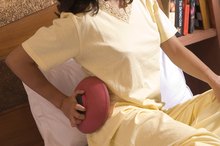Causes of Bilateral Hip Pain in Women
Numerous conditions can cause bilateral hip pain in women. Hip pain can be caused by hip joint structures, along with muscles, tendons and other tissues that act on or stabilize the hip joint. Some hip-related conditions occur on one side of the hip, while other conditions occur on both sides. Pain in both hips is called bilateral hip pain, and bilateral hip pain can affect both men and women.
If you are experiencing serious medical symptoms, seek emergency treatment immediately.
Degenerative Joint Disease
Degenerative joint disease, also known as osteoarthritis, can cause bilateral hip pain in women, especially older women. Hip degenerative joint disease affects the articular cartilage, a layer of smooth tissue that covers the head of the femur, or thighbone, and lines the socket of the hip joint. Articular cartilage allows the head of the femur to move around without pain inside the socket. Over time, with hip degenerative joint disease, a woman may experience hip pain as the cartilage wears away and bones begin rubbing together. Hip degenerative joint disease can occur in one or both hips.
- Degenerative joint disease, also known as osteoarthritis, can cause bilateral hip pain in women, especially older women.
- Over time, with hip degenerative joint disease, a woman may experience hip pain as the cartilage wears away and bones begin rubbing together.
Hip Bursitis
What Are the Causes of Leg Pain & Waist Pain?
Learn More
Hip bursitis is a common condition that can cause bilateral hip pain in women. Hip bursitis occurs when one of the bursa, a fluid-filled sac located between ligaments or tendons and bone, becomes inflamed. Bursa act like cushions between the moving tissues, helping reduce friction and preventing pain. The greater trochanter is the bony point on the upper outside portion of the thigh. Common signs and symptoms associated with hip bursitis include pain at the point of the hip and the outside aspect of the thigh, pain in the affected area that is worse at night, and hip pain with prolonged walking or stair climbing.
- Hip bursitis is a common condition that can cause bilateral hip pain in women.
- Common signs and symptoms associated with hip bursitis include pain at the point of the hip and the outside aspect of the thigh, pain in the affected area that is worse at night, and hip pain with prolonged walking or stair climbing.
Polymyalgia Rheumatica
Polymyalgia rheumatica is a painful condition that can affect both hips in women 4. Polymyalgia rheumatica is an inflammatory condition that causes muscle pain and stiffness throughout the body 4. According to MayoClinic.com, the most commonly affected body parts include:
- the neck
- shoulders
- upper arms
- hips
- thighs
Polymyalgia rheumatica-related symptoms usually manifest quickly over a period of several days 4. MayoClinic.com states that polymyalgia rheumatica usually targets people over the age of 65 and, only in rare cases does the condition affect people younger than 50 4. Common signs and symptoms associated with polymyalgia rheumatica include
- bilateral hip pain
- upper arm tenderness
- stiffness in affected areas
- decreased range of motion in involved segments
- fever
- fatigue
- malaise
- loss of appetite
- unintentional weight loss
- depression 4
Related Articles
References
- Mayo Clinic: Hip Pain
- Milton S. Hershey Medical Center: Osteoarthritis of the Hip
- American Academy of Orthopaedic Surgeons: Hip Bursitis
- Mayo Clinic: Polymyalgia Rheumatica
- "Questions and Answers about Polymyalgia Rheumatica and Giant Cell Arteritis." National Institute of Arthritis and Musculoskeletal and Skin Diseases. April 2010.
- Dasgupta B. et al. "2012 Provisional Classification Criteria for PolymyalgiaRrheumatica: A European League Against Rheumatism/American College of Rheumatology collaborative initiative." Arthritis & Rheumatism. April 2012. doi:10.1136/annrheumdis-2011-200329
- Docken, MD., WP. "Polymyalgia Rheumatica." American College of Rheumatology. Updated August 2009.
- Klippel J. et al. "Primer on the Rheumatic Diseases. Polymyalgia Rheumatica." Pages 404-406. Thirteenth Edition. Arthritis Foundation.
Writer Bio
Martin Hughes is a chiropractic physician, health writer and the co-owner of a website devoted to natural footgear. He writes about health, fitness, diet and lifestyle. Hughes earned his Bachelor of Science in kinesiology at the University of Waterloo and his doctoral degree from Western States Chiropractic College in Portland, Ore.









